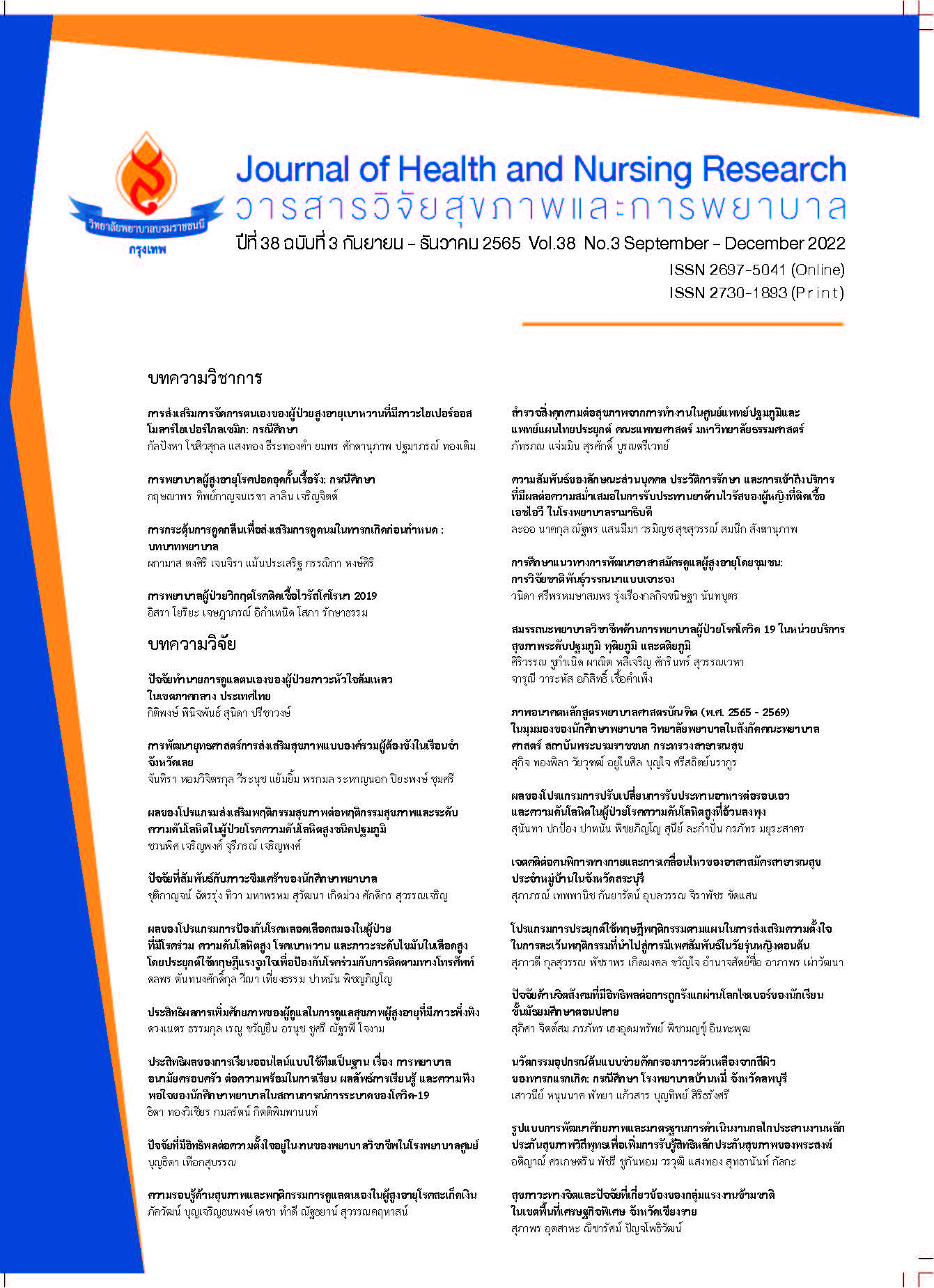ปัจจัยด้านจิตสังคมที่มีอิทธิพลต่อการถูกรังแกผ่านโลกไซเบอร์ ของนักเรียนชั้นมัธยมศึกษาตอนปลาย
คำสำคัญ:
ปัจจัยด้านจิตสังคม, การถูกรังแกผ่านโลกไซเบอร์ , นักเรียนชั้นมัธยมศึกษาตอนปลายบทคัดย่อ
บทนำ: นักเรียนชั้นมัธยมศึกษาตอนปลายเป็นวัยรุ่นกลุ่มหนึ่งที่มีรายงานเกี่ยวกับการถูกรังแกผ่านโลกไซเบอร์ ซึ่งการถูกรังแกผ่านโลกไซเบอร์นั้นเกี่ยวข้องกับหลายปัจจัย ทั้งปัจจัยด้านตัวนักเรียนและปัจจัยด้านสังคมสิ่งแวดล้อม
วัตถุประสงค์การวิจัย: เพื่อศึกษาการถูกรังแกผ่านโลกไซเบอร์ และอำนาจการทำนายของปัจจัยด้านจิตสังคมต่อพฤติกรรมการถูกรังแกผ่านโลกไซเบอร์ของนักเรียนชั้นมัธยมศึกษาตอนปลาย ในเขตอำเภอเมือง จังหวัดบุรีรัมย์
ระเบียบวิธีวิจัย: การศึกษาครั้งนี้เป็นการวิจัยแบบหาความสัมพันธ์เชิงทำนาย กลุ่มตัวอย่าง 134 คน โดยการสุ่มตัวอย่างอย่างง่าย เก็บรวบรวมข้อมูลด้วยแบบสอบถาม 8 ด้าน ได้แก่ 1) ข้อมูลส่วนบุคคล 2) การเห็นคุณค่าในตนเอง 3) พฤติกรรมติดอินเทอร์เน็ต 4) การสนับสนุนทางสังคม 5) สัมพันธภาพระหว่างนักเรียนกับผู้ปกครอง 6) สัมพันธภาพระหว่างนักเรียนกับเพื่อน 7) สัมพันธภาพระหว่างนักเรียนกับครู และ 8) การถูกรังแกผ่านโลกไซเบอร์ ได้ค่าสัมประสิทธิ์แอลฟาครอนบาคของแบบสอบถามในส่วนที่ 2-8 เท่ากับ .83, .94, .95, .84, .93, .88 และ .89 ตามลำดับ วิเคราะห์ข้อมูลด้วยสถิติเชิงพรรณนา และการวิเคราะห์ถดถอยพหุคูณแบบขั้นตอน
ผลการวิจัย: พบว่ากลุ่มตัวอย่างมีคะแนนเฉลี่ยการถูกรังแกผ่านโลกไซเบอร์เท่ากับ 24.88 (SD = 4.76) ถือเป็นการถูกรังแกผ่านโลกไซเบอร์ในระดับต่ำ ปัจจัยด้านจิตสังคมที่สามารถทำนายการถูกรังแกผ่านโลกไซเบอร์ได้อย่างมีนัยสำคัญทางสถิติ ได้แก่ พฤติกรรมติดอินเทอร์เน็ต (β = .297, p <.001) และสัมพันธภาพระหว่างนักเรียนกับผู้ปกครอง (β = -.167, p < .05) โดยสามารถร่วมกันทำนายความแปรปรวนของการถูกรังแกผ่านโลกไซเบอร์ได้ร้อยละ 13.30 (R2 = .133, p < .05)
สรุปผล: ปัจจัยด้านจิตสังคมที่สามารถทำนายการถูกรังแกผ่านโลกไซเบอร์ ได้แก่ พฤติกรรมติดอินเทอร์เน็ตและสัมพันธภาพระหว่างนักเรียนกับผู้ปกครอง
ข้อเสนอแนะ: พยาบาลวิชาชีพ บุคลากรด้านสุขภาพ คณาจารย์ด้านการศึกษา สามารถนำผลการวิจัยไปใช้เพื่อการป้องกันและลดปัญหาการถูกรังแกผ่านโลกไซเบอร์ของนักเรียนในชั้นมัธยมศึกษาตอนปลาย โดยส่งเสริมการใช้อินเทอร์เน็ตอย่างสร้างสรรค์ และการมีสัมพันธภาพที่ดีระหว่างนักเรียนกับผู้ปกครอง
Downloads
เอกสารอ้างอิง
National Crime Prevention Council. Information and resources to curb the growing problem of cyberbullying [Internet]. 2014 [cited 2021 February 15]. Available from: https://www.ncpc.org/resources/cyberbullying/
Jones SE. Examining cyberbullying bystander behavior using a multiple goals perspective [Master’s thesis]. University of Kentucky; 2014.
Songsiri N. Relationship between personal characteristics family context and cyberbullying among secondary and vocational students in Bangkok [Master’s thesis]. Bangkok: Mahidol University; 2010. (in Thai).
Hinduja S, Patchin JW. Bullying, cyberbullying, and suicide. J Archives of Suicide Research 2010;14(3):206-21.
Brewer G, Kerslake J. Cyberbullying, self-esteem, empathy and loneliness. J Computer in Human Behavior 2015;48:255-60.
Ojedokun O, Idemudia ES. The moderating role of emotional intelligence between PEN personality factors and cyberbullying in a student population. Life Science J 2013;10(3):1924-30.
Tudkuea T, Laeheem K, Sittichai R. Guidelines for preventive cyber bullying behaviors among secondary school students in the three southern border provinces. J Behavioral Science for Development 2019;11(3):91-106. (in Thai).
Ortega RR, Nunez JC. Bullying and cyberbullying: research and intervention at school and social contexts. Psicothema 2012;24(4):603-7.
Alvarez GD, Nunez JC, Dobarro A, Rodriguez C. Risk factors associated with cybervictimization in adolescence. International J of Clinical and Health Psychology 2015;43(3):1-10.
Sittichai R, Tudkuea T. Cyberbullying behavior among youth in the three southern border provinces, Thailand. Academic Services J Prince of Songkla University 2017;28(1):86-99. (in Thai).
Suntornvijitr S, Hengudomsub P, Vatanasin D, Dethchaiyot P. Predicting factors of depression among secondary school students in extended educational opportunity schools. Nursing J of the Ministry of Public 2017;28(2):53-66. (in Thai).
Olenik SD, Heiman T. Cyberbullying victimization in adolescents as related to body esteem, social support, and social self-efficacy. The J of Genetic Psychology 2017:178(1):28-43.
Bandura A. Social foundations of thought and action: a social cognitive theory. New jersey: Prentice-Hall; 1989.
Polit DF. Beck CT. Nursing research: generating and assessing evidence for nursing practice 10th ed. Philadelphia: Lippincott Williams & Wilkins; 2017.
Rosenberg M. Society and the adolescent self-Image. Princeton: Princeton University Press; 1965.
Srisaeng P. Self-esteem, stressful life events, social support and postpartum depression in adolescent mothers in Thailand [doctoral’s thesis]. Case Western Reserve University; 2003.
Nuphannoi R, Thaweekoon T, Nintachan P. Self-esteem, social support, and bullying behavior among junior high school students. The J of Psychiatric and Mental Health 2018;32(3):13-32. (in Thai).
Young KS. Internet addiction: The emergence of a new clinical disorder. J Cyber Psychology & Behavior 1998;1(3):237-44.
Thongkambunjong W. Causal factors of internet dependency behavior of high school students in Bangkok Metropolis [doctoral’s thesis]. Srinakharinwirot University; 2010. (in Thai).
Seangsanaoh S, Vatanasin D, Hengudomsub P. Influence of interpersonal factors on depression among late adolescents [Master’s thesis]. Chonburi: Burapha University; 2017. (in Thai).
Weinert C. PRQ2002 [Internet]. 2002 [cited 2021 January 8]. Available from: http://www.montana.edu/cweinert/prq2k.html
Tungmephon P. Social support, caregiving preparedness and stress among mothers of autistic children [Master’s thesis]. Chiang Mai: Chiang Mai University; 2008. (in Thai).
Changpradub A. Factors affecting on interpersonal relationship between students and their peer group of the third level, secondary grades 1-3 student of Inburi school in Inburi District, Singburi Province [Master’s thesis]. Srinakharinwirot University; 2007. (in Thai).
Thitipanichayangkoon T. Some factors affecting emotional stability and adversity guotient of Matthayomsuksa III students in Bangkok Educational service area III [Master’s thesis]. Srinakharinwirot University; 2007. (in Thai).
Pongpetra S. Factors affecting on interpersonal relationship with friends of the fourth level, secondary grades 4-6 students at Sarasas Ektra School in Yannawa District, Bongkok [Master’s thesis]. Srinakharinwirot University; 2010. (in Thai).
Doane AN, Kelley ML, Chiang ES, Padilla MA. Development of the cyberbullying experiences survey. Emerging Adulthood 2013;1(3):207-18.
Phaowiriya H, Boonnate N, Dallas CJ, Suppaseemanont W. Cyberbullying behavior and cybervictimization among nursing students. Nursing J 2021;48(1):159-73. (in Thai).
Sanga S, Yapang P, Chanthon T. Cyber bullying behavior of senior secondary school students in Muang District, Lumphun Province. The 13th National and International Sripatum University Conference; 2018 Dec 20; 2018. p.1953-64. (in Thai).
Amaraphibal A. Cyber-bullying victimization among youths: risk factor, mental health impacts and reporting to the third person. Research Methodology & Cognitive Science 2016;14(1):59-73. (in Thai).
Kerim K, Mustafa O, Subhan E, Duygu GE, Songul Y, Dilvin E, et al. Determination of the level of being cyber bully/victim of eighth grade students of elementary schools. Procedia-Social and Behavioral Sciences 2015;176(2015):846-53.
Pornnoppadol C. Behavior use internet not safe in Thai children: Cyberbullying [Internet]. 2019 [cited 2020 Feb 8]. Available from: https://today.line.me/th/v2/article/aEOgPO
Nantasen P, Prasertsin U. Internet addiction behavior and depression: causes, factors, and prevention guidelines. J of Health and Nursing Research 2020;36(3):293-303. (in Thai).
Pokpong S, Musikaphan W. Factors affecting attitudes and behavior violence and cyberbullying among youth in Thai [Master’s thesis]. Bangkok: Mahidol University; 2009. (in Thai).
Jandee P, Vatanasin D, Hengudomsub P. Factors influencing depression among secondary school students in extended educational opportunity schools. J of Health and Nursing Research 2021;37(1):252-65. (in Thai).
ดาวน์โหลด
เผยแพร่แล้ว
รูปแบบการอ้างอิง
ฉบับ
ประเภทบทความ
สัญญาอนุญาต
ลิขสิทธิ์ (c) 2022 Journal of Health and Nursing Research (Journal of Boromarajonani College of Nursing, Bangkok)

อนุญาตภายใต้เงื่อนไข Creative Commons Attribution-NonCommercial 4.0 International License.
บทความที่ได้รับการตีพิมพ์ เป็นลิขสิทธิ์ของวารสารวิจัยสุขภาพและการพยาบาล (วิทยาลัยพยาบาลบรมราชชนนี กรุงเทพ) ไม่สามารถนำไปตีพิมพ์ซ้ำในวารสารฉบับอื่น


















